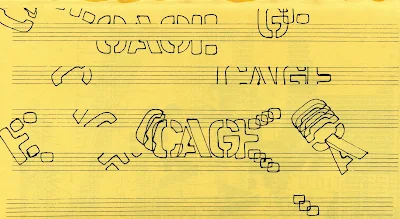 |
| John Cage poem by Stephen Morrissey |
 |
| Cut-up poem from around 2010 by Stephen Morrissey |
The process of making cut-ups is fairly simple. Take a page of someone’s writing—for instance Arthur Rimbaud or Blaise Cendrars—and cut the page into four, eight, ten, or whatever number of pieces one chooses. Then, randomly assemble the cut-up pieces of text by gluing them onto a fresh sheet of paper. Now, you have a new piece of writing by the same author, but changed, the words altered, a new voice speaking through the random assemblage of fragments of their work. The linear writing you began with has been re-visioned in a non-linear way, often producing surprising new phrases that contradict normal rational logic. As a variation on this process, you can take two authors, cut-up their writing, and assemble a new, single, and combined page of, for instance, Rimbaud-Cendrars.
I learned of the cut-up method in William Burroughs and Brion Gysin’s book Minutes to Go that I read in the early 1970s. I was just beginning to read my work in public and the cut-ups made a huge impression on me at the time. Indeed, the writings of Jack Kerouac and Allen Ginsberg, Gregory Corso and William Burroughs, and others, spoke to many of us in a personal and relevant way. Writing poetry was our journey and these older writers were our mentors. I also read all of Henry Miller and Anaïs Nin, and other writers that Henry Miller recommended in his The Books in my Life; indeed, that’s where I first heard of Blaise Cendrars and, possibly, J. Krishnamurti. At the time of these early public readings and performances, I was also involved with the writings of John Cage that emphasized silence, randomness, coincidence/synchronicity, and non-linearity in art. I have always liked several things about making cut-ups: For instance, 1) the physicality (or non-cerebral aspect) of the cut-ups, using scissors and glue to create new writing; 2) the relationship of the cut-ups to making collages, which are really visual cut-ups; 3) I have always been intrigued by the randomness of the cut-ups, allowing a new voice to emerge from the writing; 4) the connection to visual art (painting, film, etc.) interested me; 5) avoiding the imposition of the ego in the writing, always seemed to me one of the objectives I was attempting to achieve in my experimental writing; 6) cut-ups can be performed using several voices, or a room full of voices, or the reading/performance can have several cut-ups read simultaneously.
The cut-ups remind us of a serious ambition in poetry, in sound poetry, in visual poetry, and in printed poetry. In my writing since the cut-ups—writing concerned with redemption and witness—the context has always been living in an existential world in which insight and affirmation of life has been hard-won. The cut-ups affirm life, they show meaning and creativity in randomness and coincidence.
A final note: you can't escape the trickster archetype in all of this. The idea of new, intelligible poems coming from the cut-up remains of someone else's poems suggests a supreme act of disrupting our usual way of thinking about life. Are our poems so slight, or so dense, that a new and possibly significant text can be found after its cut-up pieces are randomly assembled? Is the cut-up up technique also some kind of manifestation of the trickster? Of course, it’s all a part of the same process...
30 October, 2008
Addendum
William Burrough's "fold-in" technique
William S. Burroughs' "fold-in" method is a literary technique where two pages of text with the same line spacing are folded vertically and placed on top of each other. The new text is then read by taking half of each original page, creating a composite text that can produce new narratives and meanings. It was a variation of the broader cut-up technique that Burroughs developed with Brion Gysin.
How it works
Preparation: Take two pages of text—which can be your own writing or someone else's—and ensure they have the same line spacing.
Folding: Fold each page in half vertically.
Combining: Place the two folded pages on top of each other.
Reading: Read across the resulting composite page, taking half of the first text and half of the second text for each line.
Purpose and effects:
New narrative: The method creates new and unexpected combinations of words and phrases, leading to a new narrative or a different perspective on the original texts.
Temporal shifts: Burroughs used it to create effects like flashbacks by folding page one into page one hundred and placing it as page ten, creating a temporal loop for the reader.
Discovering meaning: Burroughs and Gysin believed the technique could reveal the implicit or "true" meaning of a text by disrupting its linear structure.
Clarity and comprehensibility: Interestingly, Burroughs noted that sometimes the composite text produced by the fold-in method was clearer than the original texts.
Revised: 20 October 2025



